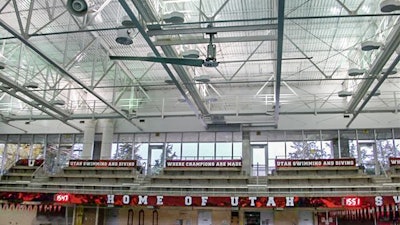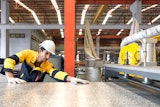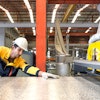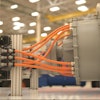
The University of Utah’s Ute Natatorium has been one of the leading collegiate swimming and diving venues in the country for over four decades. Home of the school’s men’s and women’s swimming teams, the facility regularly hosts Pac 12 Conference and other NCAA Division I competitions and has hosted the NCAA Division I National Championship. Situated in the university’s Huntsman Center athletic complex, it contains a six-lane, 25-yard training pool; an eight-lane, 25-yard competition pool; and a 20 x 15 yard diving well with four diving boards.
Built in 1968, the fan-friendly venue has received a number of renovations designed to make it even more appealing as an NCAA competition site. These renovations have included expansions of the natatorium’s diving well, team locker rooms and the addition of a team meeting lounge. One of the most recent upgrades, however, benefits athletes, spectators and student facility users alike: the installation of a high volume, low speed fan from Rite-Hite.
Like many pool facilities, the Ute Natatorium had a very noticeable chlorine smell. While chlorine is a necessary disinfectant to protect the health of swimmers, bathers and other pools and spas patrons, the chloramines created during the chlorine disinfection process can pose serious health risks as they build up in the water and become airborne. Symptoms of over-exposure are irritation to eyes, nose, mouth and/or lungs.
On the heels of the natatorium’s other improvements, the University decided the time had come to address the chlorine-odor situation as well, and the facility’s management was directed to find a solution. Assistant Director of Events and Facilities Steve Riley headed up this effort and soon began working with local building consultant Alan Jarvis of Arbon Equipment Corporation to develop a plan.
The natatorium had previously used high speed ceiling fans to control chlorine odors. However, the high speed ceiling fans were very loud and couldn’t be run continuously. While they did vent the chlorine smell when turned on, the odors quickly built back up when the fans were off. Heat and humidity were also problematic, particularly in the natatorium’s bleachers.
After studying several options, Riley soon honed in on an approach using high volume, low speed (HVLS) fans. Utah’s Athletic Department had already had success with HVLS fans, having installed four 24-foot diameter models to combat heat in their indoor football facility, as well as two 12-foot models in their football locker room.
As their name implies, HVLS fans are designed to move large volumes of air; in fact, one HVLS fan can cover an area up to 22,000 sq. ft. This increased air movement can help disperse concentrations of airborne chemical fumes, including those from chloramines. For the natatorium application, Riley and Jarvis determined that they could sufficiently disperse the odor with a single, 24-foot diameter, 2-blade fan.
The fan’s benefits became apparent almost immediately after it was installed. “I was shocked at how much difference the fan made,” said Riley. “The smell was noticeably different – the chlorine odor was all but gone. Everyone noticed it.”
The reduction of chloramine in the air wasn’t just documented by the noses of Riley, the swim teams and other natatorium users. Air quality readings taken by the university’s College of Health verified those olfactory opinions. While specific data hasn’t been made public, the College of Health did note that chloramine levels in the natatorium were “significantly lower” in readings taken after the fan installation.
The university also discovered that the HVLS fan installation delivered a host of side benefits to the natatorium. Not only were fans in the bleachers enjoying cooler and less humid surroundings, the fan hindered the formation of condensation. That made the pool’s walkway areas dryer and less slippery for swimmers and floor-level personnel.
Today, more than a year after their installation, Riley remains thrilled with the decision to install the HVLS fan system. “The renovations we’d done addressed all the big issues with this building, except for the chlorine smell,” said Riley. “That complaint is now gone.”























